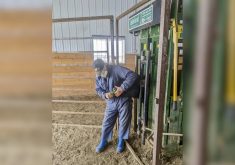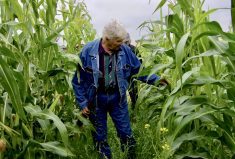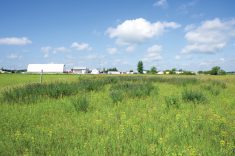The first summer after COVID restrictions were lifted has been busier than ever at Manitoba Beef and Forage Initiatives (MBFI).
“We’ve really made a big push this summer,” Mary-Jane Orr, MBFI’s general manager, told the Co-operator. “This year, we have hosted more events than ever.”
Those events included working with Manitoba Agriculture and Ducks Unlimited to host a six-part grazing workshop series. It also hosted a summer barbecue with Manitoba Beef Producers and a forage feast day.
Read Also

Mandatory holiday joy a valid struggle
Christmas may not be that jolly for everyone. Farm family coach Kalynn Spain suggests those struggling with over-the-top joy during the holidays instead aim for “fulfilled” or “content.”
Orr says it’s great to get back to business. The grand opening of the Learning Centre was in fall 2018. In 2019, MBFI had a “fantastic” year, and then the pandemic brought everything to a halt. Seeing the programming and in-person engagement return is encouraging, Orr said.
MBFI was incorporated as a not-for-profit organization in 2014. It was created to address a gap in on-farm evaluation and demonstration in western Manitoba and eastern Saskatchewan. It coincided with the end of operations at the Manitoba Zero Till Association research farm and the shuttering of Agriculture and Agrifood Canada’s (AAFC) beef research program at the Brandon Research and Development Centre in 2013.
“That created an opportunity for these two different farm stations (the Brookdale and Johnson research stations) to be consolidated into this new not-for-profit research and demonstration organization,” Orr said.

The first field season was in 2015, but it wasn’t until 2016 that the infrastructure was in place to do solid data collection. The next big milestone for MBFI was the opening of its learning centre at the Brookdale Research Farm in fall 2018, around the same time Orr was hired as general manager.
MBFI is a partnership between Manitoba Agriculture, Manitoba Beef Producers, Manitoba Forage and Grasslands Association and Ducks Unlimited Canada. While it’s easy to understand the link between the first three, Orr says the synergy with a conservation organization like DUC is also natural.
“Livestock do a phenomenal job of sharing the land base that they’re using, so they create habitat and increase biodiversity across managed grasslands,” she said.
“Ducks Unlimited recognizes that huge role. They are an active partner in the Canadian Roundtable for Sustainable Beef. They were a big part of the ‘Guardians of the Grassland’ film that came out in support of maintaining livestock on the landscape.”
The relationship between agricultural producers and environmental sustainability underscores the raison d’être of MBFI and reflects its commitment to concepts like regenerative agriculture. There’s an emphasis not only on farming, but farming well; preserving land and also improving it. Its mission statement focuses on the “three E’s:” engage, evaluate and extend.
The idea is to engage producers and stakeholders, do on-farm evaluations, extend and promote the values and practices championed by the organization. Producers play a huge role in this formula as the recipients of knowledge and research at MBFI as well as active participants in the process.
While organizers keep tabs on global innovators and look at trends around the world, they also engage local producers with their ideas.
“We’re having conversations and engaging producers that are leading-edge innovators, and then seeing what they’re really excited about,” Orr said. “We’re seeing if it makes sense to build that into something for an on-farm evaluation on MBFI.”
Practical
In terms of what makes sense, it’s not only about being environmentally conscious. It has to have potential in the real world. MBFI research centres are fully operational farms, and sustainability works both ways.
“These cows need to be fed 365 days a year, and I need to generate feed for them,” Orr said. “I do have the opportunity to be creative in how I manage that farm. So, I incorporate decisions based on regenerative agricultural principles, but the farm has to pay for itself. It has to break even.”

MBFI is also indispensable to scientific research done at Manitoba Agriculture. It coordinates with the Manitoba Agriculture Diversification Centres to identify small plot research that should be scaled up to mid-sized, five-to-eight-acre plots.
“A unique strength of MBFI is that we’re that mid-level point in the line between small plot research and broad-acre application of practices,” Orr said.
A current example is an ongoing study of a new-to-Manitoba forage grass from Africa called teff. That project came to fruition through conversations with Manitoba Agriculture’s James Frey, who works out of the Parkland Crop Diversification Foundation (PCDF) office in Roblin. Frey had promising results from the PCDF research farm and contacted MBFI to see if it was interested in doing trials.
“That was an opportunity to do a spur of the moment, fluid adaptation,” Orr said.
So, eight years since its inception and six years after it began actively collecting data, Orr offers an evaluation of where things stand and where they are heading.
“We’ve been trying to build the ship and sail it at the same time,” she said. “Slowly but surely, we’re getting the ship’s organizational bones built. And now we’re able to focus more and more on just sailing it.”
For Orr, this is an exciting time as she sees goals achieved.
As she looks forward to fall programming and plans for 2023, she asks farmers to reach out through the mbfi.ca website.
“We’re only as good as the feedback we receive and we really want to hear from producers so we can continue to improve our programming,” she said.
















